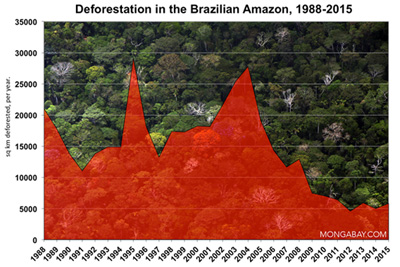Brazil will propose limiting the amount of carbon an industrialized country can offset via a proposed forest conservation initiative to ten percent of their emissions, reports Bloomberg.
Brazil, which is home to the greatest extent of tropical forest and has the highest annual deforestation rate, will make the proposal at next week’s climate conference in Copenhagen. The country has already announced it will support the so-called REDD scheme, a U.N. program that will compensate tropical countries for reducing greenhouse gas emissions generated through deforestation and forest degradation.
Until recently Brazil’s support for REDD has been somewhat tentative due to concerns that the mechanism would let rich countries “of the hook” for emissions, allowing them to continue polluting by simply paying poor countries not to cut down their trees. But Brazil has come around to the idea as its leaders have come to terms with the amount of money REDD could deliver as well as the apparent inevitability that the some form of REDD will figure prominently in the next global climate framework.

|
“After five rounds of negotiations with the governors from the Amazon, we decided to incorporate REDD in our national proposal, but under certain conditions,” Environment Minister Carlos Minc said at a news conference.
Brazil has already laid out an ambitious plan to cut deforestation rates by nearly 70 percent over the next 10 years. The move would avoid billions of tons in CO2 emissions. Brazil expects industrialized countries to help pick up the tab — Norway pledged up to a billion dollars to the Amazon Fund last year, conditional on Brazil’s success in meeting its targets.
Related
Concerns over deforestation may drive new approach to cattle ranching in the Amazon

(09/08/2009) While you’re browsing the mall for running shoes, the Amazon rainforest is probably the farthest thing from your mind. Perhaps it shouldn’t be. The globalization of commodity supply chains has created links between consumer products and distant ecosystems like the Amazon. Shoes sold in downtown Manhattan may have been assembled in Vietnam using leather supplied from a Brazilian processor that subcontracted to a rancher in the Amazon. But while demand for these products is currently driving environmental degradation, this connection may also hold the key to slowing the destruction of Earth’s largest rainforest.
Brazil’s plan to save the Amazon rainforest

(06/02/2009) Accounting for roughly half of tropical deforestation between 2000 and 2005, Brazil is the most important supply-side player when it comes to developing a climate framework that includes reducing emissions from deforestation and forest degradation (REDD). But Brazil’s position on REDD contrasts with proposals put forth by other tropical forest countries, including the Coalition for Rainforest Nations, a negotiating block of 15 countries. Instead of advocating a market-based approach to REDD, where credits generated from forest conservation would be traded between countries, Brazil is calling for a giant fund financed with donations from industrialized nations. Contributors would not be eligible for carbon credits that could be used to meet emission reduction obligations under a binding climate treaty.